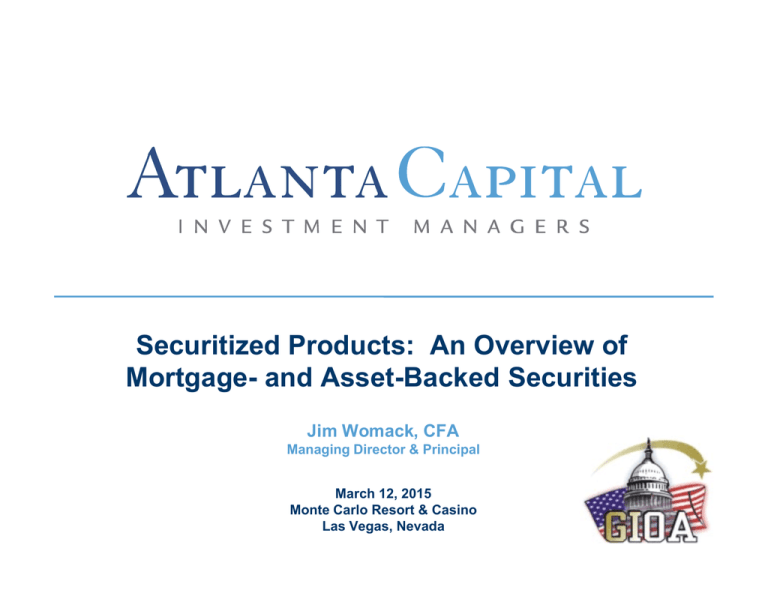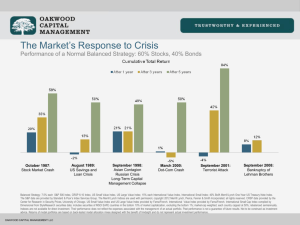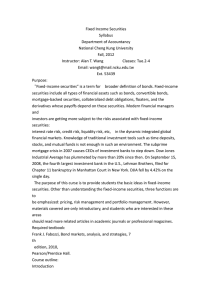Securitized Products: An Overview of Mortgage- and Asset
advertisement

Securitized Products: An Overview of Mortgage- and Asset-Backed Securities Jim Womack, CFA Managing Director & Principal March 12, 2015 Monte Carlo Resort & Casino Las Vegas, Nevada Mortgage-Backed & Asset-Backed Securities: What Are They and How Are They Different From Other Bonds? Generally Speaking: • Bonds backed by many ( thousands) (or th d ) off borrowers. b • Credit worthiness is often independent of the issuer. • Significant credit support at issuance that builds over time • St Strong credit dit profile fil nott reliant on asset valuations. Unique Advantages of MBS / ABS: • Efficiently Achieve Greater Credit and Economic Diversity • Gain Credit Stability Through Even the Worst of Market Conditions • Reduce or Eliminate the Event Risk Inherent in Single Credit Issues • Attractive Yields vs. Other Types of Lower Rated Bonds -2- High Credit Quality and Cash Flow Stability An “Apples to Apples” Comparison of Historical Excess Returns DURATION ANNUAL EXCESS RETURN Merrill Lynch AAA Credit Card ABS 2.3 Years* 0.89%** Merrill Lynch 1-3 Year Agency CMO PAC 1.9 Years* 0.84%** Merrill Lynch AAA Auto ABS 1.3 Years* 0.84%** Merrill Lynch 1-3 Year Corporate (AAA-A) 1.9 Years* 0.75%** Merrill Lynch 1-5 1 5 Year Corporate (AAA (AAA-A) A) 2.8 Years* 0.67%** Merrill Lynch 1-3 Year Callable Agencies 1.4 Years* 0.14%*** SECTOR INDEX * ** *** Data as of December 31, 2014 Annualized duration adjusted excess return vs. Treasuries since December 1996 (earliest available excess return data on ABS) Annualized duration adjusted excess return vs. Treasuries since December 1998 (earliest available excess return data on Callable Agencies) Source: Merrill Lynch & Bloomberg -3- Mortgage-Backed & Asset-Backed Securities: High Credit Quality, Low Event Risk and Stable Return Profile ‘AAA’ Securitized, ‘A’ Rated Corporate & Agency Cumulative Excess Returns 15.0% 10.0% 5.0% 0.0% -5.0% -10.0% 1997 1999 2001 2003 2005 2007 2009 1-3 1 3 Year AAA-Rated AAA Rated Securitized Index 1-3 Year A-Rated Industrials Index 1-3 Year Agency Index Source: Barclays Capital, BofA Merrill Lynch Inception of BofA Merrill Lynch Excess Return data is 12/31/1996 -4- 2011 2013 Asset-Backed Securities: The Basics Non-Housing Related Receivables in Bankruptcy Remote Structures AAA Rated ABS Trust AA Rated A Rated BBB Rated -5- Asset-Backeds: Remembering The Great Financial Crisis Not The Headlines You Remember! “Most Senior GMAC prime auto ABS ratings able to withstand ‘depression’ unemployment scenario.” - Moody Moody’s s Investor Service, Service 5-12-09 5 12 09 “Moody’s has placed fifteen tranches from eight loan securitizations sponsored by Ford Motor Company in 2006 and 2007 on review for possible upgrade. The build up of credit enhancement more than offsets modest increases in lifetime cumulative losses observed in the underlying y g collateral p pools.” - Moody Moody’s s Investor Service, Service 8 8-21-09 21 09 “Auto-loan Backing is Popular; Investors Like These Tried and Tested Securities Securities” - Headline, Headline Wall Street Journal Journal, 9-16-2009 “Due to available credit enhancement and structural protections, ratings for prime senior tranches of ABS auto loan transactions have remained stable year-to-date.” - Fitch Ratings, 10-26-09 -6- Asset-Backeds: How The Typical Auto Structure Works Two Types of Credit Support: Overcollateralization & Subordination Overcollateralization Lesser Amount L A t off Bonds Backed by Loans Pool of Auto Loans Subordination Still Lesser Amount Of Senior (AAA Rated) Bonds Backed by Loans Lesser Amount of Bonds Backed by Loans -7- Asset-Backeds: How The Typical Auto Structure Works Subordination Protects The Senior Note Holders 5 Ways Class Rating Size Percent A1 A2-A A2 A A2-B A3 A4 AAA AAA AAA AAA AAA 210,000,000 400,000,000 450,000,000 592,000,000 249,260,000 93.0% B AA 60,200,000 5th Loss Protection 3.0% C A 40,135,000 4th Loss Protection 2.0% D BBB 40,135,000 3th Loss Protection 2.0% Reserve Account 2nd Loss Protection 0.8% R Reserve A Accountt 1 tL 1st Loss Protection P t ti 1 0% 1.0% Total Subordination For Senior Note Holders Overcollateralization at Origination g Total Credit Support to Senior Bondholders -8- 8.8% 5.7% 14.5% Asset Backeds: How The Typical Auto Structure Works Historically, Even The Lowest Rated Bonds Have Been Well Protected Fitch Prime Auto ABS Cumulative Net Loss Index 1.5% 1.5% Rolling 12-Months Monthly 1.2% 1.2% 0.9% 0.9% 0.6% 0.6% Source: Fitch Ratings Class 0.2% Rating Size Percent A1 AAASource: Fitch 210,000,000 Ratings A2-A 0.0% AAA 400,000,000 A2-B AAA 450,000,000 9/93 9/94592,000,000 9/95 9/96 9/97 9/98 A3 AAA A4 AAA 93.0% 249,260,000 B AA 60,200,000 , , 3.0% % C A 40,135,000 2.0% D BBB 40,135,000 2.0% Reserve Account 0.8% Reserve Account % 1.0% Total Subordination For Senior Notes Overcollateralization at Origination 8.8% 5.7% Total Credit Support to Senior Notes 0.3% 0.0% 2001 2003 14.5% -9- 2005 2007 2009 2011 2013 Asset-Backeds: How The Typical Auto Structure Works Natural Deleveraging: The Credit Enhancement Grows As Bonds Pay Down AAA Credit Support Total Credit Support to Senior Bondholders At Origination 14.5% 15.9% A1 AAA 0.3 Year WAL 24.7% A2-A A2 A A2-B AAA 1.1 Year WAL A3 AAA 2.2 Year WAL BT Tranche, h AA R Rated, t d 4 4.4 4Y Year WAL 14.5% C Tranche, A Rated, 4.7 Year WAL D Tranche, BBB Rated, 4.9 Year WAL Reserve Accounts - 10 - 65.2% A4 AAA 3.8 Year WAL Still a Need For A Structured Approach to Investing Beyond the Rating: Ensuring High Credit Quality and Cash Flow Stability Factors to Analyze at Purchase (e.g., New Issue): Overcollateralization Subordination Underlying Loan Characteristics ~ Fico Scores (Credit Profile of Borrowers) ~ Loan Terms (Length, LTV, etc.) ~ Distribution of Loan Terms ~ Geographic Distribution Collateral Characteristics ~ New Autos vs. vs Used Autos ~ Cars vs. SUVs Sponsor/Servicer (e.g., Ford, GE, etc.) ~ Experience E i ((capabilities, biliti strategy t t and d procedures d ffor lloss mitigation) iti ti ) ~ Financial Condition - 11 - Still a Need For A Structured Approach to Investing Beyond the Rating: Ensuring High Credit Quality and Cash Flow Stability Factors for Ongoing Analysis: Deal Specific Credit Metrics ~ Delinquencies (30, 60, 90+ Days) ~ Cumulative Net Losses ~ Changes in Credit Enhancement Economic Fundamentals ~ Collateral Values (i.e., Used Auto Prices) ~ Economic Environment (unemployment, housing, gas prices, etc.) ~ Fleet Age Financial Market Conditions ~ ABS Spreads (particularly on lower rated tranches) ~ Equity Performance (stock prices of issuer/servicers ) p Debt Performance ((spreads p on corporate p debt or CDS)) ~ Corporate - 12 - Mortgage-Backed Securities The Mortgage Market Is One of the Deepest and Most Liquid Markets 12 Marketable Debt Outstanding 600 Average Daily Trading Volume $11 9 $11.9 10 $505 400 $8 7 $8.7 $ Billions $ Trillions 8 500 $7.5 6 4 2 300 200 $179 $2.1 100 $20 0 Source: The Securities Industry and Financial Markets Association 0 Data as of December 31, 2014 - 13 - $5 Mortgage-Backeds: More Yield Than Corporates…But Why? Comparing Yield of MBS vs. A Rated Corporate Bonds 10.0 30-Year MBS Pass-Through & Like Maturity A Rated Corporate Yields Yield in Perrcent 8.0 6.0 4.0 2.0 0.0 1992 1994 1996 1998 2000 2002 2004 30 Year MBS Pass-through Average Yield: 2006 5.69% AR Rated t d Corporate C t B Bond dA Average Yield: Yi ld 5.01% 5 01% Source: Merrill Lynch, Bloomberg Data as of December 31, 2014 - 14 - 2008 2010 2012 MBS Yield Advantage: 2014 0 68% 0.68% Mortgage-Backed Securities The Traditional Mortgage Pass-Through Homeowner Bank Trustees Guaranteed Timely Principal & Interest Government Sponsored Entity (Ginnie Mae, Fannie Mae, Freddie Mac) IInvestors t receive i pro-rata t share h off interest, i t t principal, and principal prepayments. Investors have uncertainty about when they get principal back back. - 15 - Investors Mortgage-Backed Securities Traditional GSE Guaranteed Mortgage-Backed Securities Key Characteristics of MBS: Bonds Receive Principal and Interest Monthly Monthly, Because Borrowers Make Monthly Mortgage Payments Borrowers Can Repay Their Loans Without Penalty and at Any Time People Prepay Their Mortgages For a Variety of Reasons They Refinance, Get Transferred, Death, Divorce, Buy Bigger/Smaller Home, Etc. The Speed of Loan Prepayment is Measured by PSA & CPR PSA = Prepayment Speed Assumption, CPR = Constant Prepayment Rate 100 PSA or 100% of the PSA model rate, calls for prepayments to start slowly and build to a 6% constant prepayment rate (CPR) after 24 months. However: If mortgage rates declined, the prepayment rate could jump because homeowners are refinancing (i.e., +200 PSA or 24CPR). - 16 - Mortgage-Backed Securities Because The Home Owner Can Prepay At Any Time, Mortgage-Backed Securities, Like Other Callable Bonds, Have Negative Convexity Price Negative Convexity +0.8% -1.2% -1% +1% - 17 - Yield Mortgage-Backed Securities Traditional 30-Year Mortgage Lending Key Characteristics of 30-Year Loans & MBS: 30-Year Loans Spread p Payments y Out to Reduce Monthly y Payment y Nearly All of The Payment In The Early Years Is Interest The e Interest te est Rate ate Level e e Impacts pacts The e Monthly o t y Payment ay e t For o tthe e Borrower o o e on a 30-Year Loan More Than on a 15-Year or 10-Year Loan (A Key Reason Why People Don’t Refinance Their Cars) So 30-Year 30 Year Borrowers Are Typically Very Rate Sensitive Borrowers Can Repay Their Loans Without Penalty and at Any Time Bondholders Receive Recei e An Attractive Attracti e Yield Above Abo e Treasuries, Treas ries Agenc Agency Iss Issued ed Debentures and Other Types of Securities Because Borrowers Can Repay Their Loans Without Penalty and at Any Time Agency MBS S are Backed by The Homeowner, by The Agency, and by The Implied Guarantee Of The Government - 18 - Mortgage-Backed Securities Traditional 30-Year Mortgage Pass-Through & Cash Flow Profile Mortgage Rates Mortgage Rates Mortgage Rates HIGHER UNCHANGED LOWER NO REFINANCE LESS Trading Up LESS Renovation LESS ESS Downsizing D i i Get Transferred Death, Divorce, Etc. Trading Up Major Renovation Downsizing Get Transferred Death, Divorce, Etc. REFINANCE MORE Trading Up MORE Renovation MORE Downsizing Get Transferred Death, Divorce, Etc. 6% CPR 12% CPR 25% CPR 5 Year Bond 2 Year Bond Per Year Per Year 8 Year Bond 3 Year Contraction 3 Year Extension - 19 - Per Year Mortgage-Backed Securities Traditional 15-Year and 10-Year Mortgage Lending Key Characteristics of 15-Year & 10-Year Loans & MBS: 15-Year & 10-Year Loans Are For People p Who Want To Pay y Debt Back Fast More of the Payment Is Principal, So The Interest Rate Has Less of an Impact on The Monthly Payment So 15-Year & 10-Year Borrowers Are Typically LESS Rate Sensitive The Shorter The Loan, The Less Variability The Cash Flows Are At a Given Prepayment Speed Borrowers Can Repay Their Loans Without Penalty and at Any Time They Have The Same Credit Backing as Bonds Backed by 30-Year Loans 15-Year and 10-Year Pass-throughs Receive An Attractive Yield Above Treasuries,, Agency g y Issued Debentures and Other Types yp of Securities,, But Less Than a 30-Year Pass-through - 20 - Mortgage-Backed Securities Traditional 10-Year Mortgage Pass-Through & Cash Flow Profile Mortgage Rates Mortgage Rates Mortgage Rates HIGHER UNCHANGED LOWER NO REFINANCE LESS Trading Up LESS Renovation LESS Downsizing Get Transferred Death, Divorce, Etc. Trading Up Major Renovation g Downsizing Get Transferred Death, Divorce, Etc. REFINANCE MORE Trading Up MORE Renovation MORE Downsizing D i i Get Transferred Death, Divorce, Etc. 7% CPR 12% CPR 25% CPR 3.4 Year Bond 2.9 Year Bond Per Year 4.0 Year Bond Per Year Per Year 0.5 Year Contraction 0.6 Year Extension - 21 - Mortgage-Backed Securities Collateralized Mortgage Obligations (CMOs) & Cash Flow Profile Homeowner Bank Trustees Guaranteed Timely Principal & Interest Government Sponsored Entity Classes Increase Cash Flow Certainty (Ginnie Mae, Fannie Mae, Freddie Mac) Investor certainty is increased. increased $ Investors in short-term, intermediate-term and long-term securities can now participate in the mortgage mortgage-backed backed securities market. - 22 - $ $ Class 1 $ $ $ Class 2 $ $ $ Class 3 Mortgage-Backed Securities The Two Main Types of Collateralized Mortgage Obligations (CMOs) Seqential Class CMO: Cash Flow Stability Improved vs. Pass-Through Since Tranches Get Paid Back In Sequential Order Big Prepayment Swings Can Still Cause Some Cash Flow Variability (e.g., A Sequential Backed By New 30 Year Loans). A Sequential Backed By Stable Collateral Can Greatly Improve Cash Flow Stability (e.g., Sequential Backed By Seasoned 15 Year Loans). Pre-Planned Ammortization Class (PAC) CMO: Can Be The Most Stable Form of Mortgage-Backed Security. Cash Flow Structured to Follow Pre-Planned Schedule Subject to Prepayment Speeds Remaining Within Stated Parameters Th The Key K is i to t Analyze A l “Stressed” “St d” Prepayment P t Assumptions A ti to t Ensure The Bond Will Act Like You Expect - 23 - Mortgage-Backed Securities Analyzing The PAC CMO Structure The PAC Can Have Stability Because Other Support Bonds Make It So. If Prepayments Are Greater Than Expected, The Support Classes Will Take The Additional Prepayments So The PAC Doesn’t Have To. If Prepayments Are Less Than Expected, The Support Classes Will Forego Principal So The PAC Gets The Desired Amount. $ $ $ Support Class 1 $ $ $ PAC CMO $ $ $ Support Class 2 Investors Typically yp y Run “Stress Tests” To Ensure The Support pp Classes Are Adequate To Provide The Required Stability For The PAC Class. - 24 - Mortgage-Backed Securities The Well Structured PAC CMO Structure Consistent Payment History Well Within Wide PAC Bands 2 Year Bond at +50 bps Over Treasuries • Often Greater Yield and Cash Flow Stability Than Callable Agencies • Yields Comparable or Higher than A-Rated Corporate Bonds. Source: Bloomberg - 25 - Mortgage-Backed Securities The Key Factors That Drive Cash Flow Stability Collateral Characteristics: L Loan Term: T Sh t Equals Shorter E l More M Stability St bilit Loan Balance: Lower Equals More Stability Seasoning (Loan Age): Longer Equals More Stability Mortgage Rate: Out-of-money Equals More Stability S Security i Structure: S Structure Often Enhances Collateral Characteristics, But There Is No Substitute For Careful Analysis. y Generally Speaking: Pre-Planned Amortization (PAC) CMO Sequential Amortization (SEQ) CMO Mortgage Pass-through - 26 - More Stability Some Stability Least Stability Mortgage-Backed Securities: “Taper Tantrum” Why So Much On Cash Flow Stability: Minimizing Extension (And Call) Risk Duration: Sample (Actual) MBS & CMO Portfolio Typical Mortgage Collateral 2.1 Years 3.2 Years Yield-to-Maturity: 1.3% 1.3% Wtd. Average $ Price: $104.2 $107.3 Wtd. Average Original Loan Term: 16 Years 30 Years Avg. Origination Date: 2004 2012 Current Avg Avg. Balance: $79K $300K Avg. Time to Maturity: 9 Years Impact of 50 Basis Point Rate Decline on Payment: Source: Merrill Lynch, Bloomberg, Atlanta Capital $19 / mo Data as of September 2012 - 27 - SHORTER LOANS MORE SEASONED 30 Years LOWER LOAN BALANCE $85 / mo MORE STRUCTURE “Taper Tantrum” Mortgage-Backed Securities: Why So Much On Cash Flow Stability: Minimizing Extension (And Call) Risk 3.0 Sample (Actual) MBS & CMO Portfolio Duration Variability 0.8% UNCHANGED 0.6% 20 2.0 0 4% 0.4% 0.2% 1.0 0.0% Mar-12 3.0 Jun-12 Sep-12 Dec-12 Mar-13 Jun-13 Sep-13 Merrill Lynch Callable Agency Index Duration Variability 0.8% 1.4 Years to 2.4 Years 0.6% 2.0 0.4% 0.2% 1.0 0.0% Mar-12 3.0 Jun-12 Sep-12 Dec-12 Mar-13 Jun-13 Sep-13 Merrill Lynch 0-3 Year CMO PAC Index Duration Variability 0.8% 1.1 Years to 2.7 Years 0.6% 2.0 0.4% 0.2% 1.0 0.0% Mar-12 Jun-12 Source: Merrill Lynch, Bloomberg, Atlanta Capital Sep-12 Dec-12 - 28 - Mar-13 Jun-13 Sep-13 “Taper Tantrum” Mortgage-Backed Securities: Whyy So Much On Cash Flow Stability: y Minimizing g Extension ((And Call)) Risk Negative Convexity (e.g., The 1-Year, Non-Call, 5-Year Callable Bond) Purchase Date 1 Year 5 Year Call Date Maturity D t Date (Yield to Call) (Duration to Call) May-August Return 1-Year T-Note Index Return: 0.14% 1.0 yr 0.07% 1-Year, NC 5-Year Callable Bond: 0.97% 1.0 yr (2.96%) April 30 Yield Duration Reaching for Yield Adding yield almost always means adding some form of risk (credit risk, duration, negative convexity, etc.). It’s important to understand the risks with each investment and how they impact the overall portfolio. Source: Merrill Lynch, Bloomberg - 29 - “Taper Tantrum” Mortgage-Backed Securities: Why So Much On Cash Flow Stability: Minimizing Extension (And Call) Risk Merrill Lynch Mortgage Index Merrill Lynch 1-5 Callable Index Sample (Actual) MBS & CMO Portfolio Effective Duration (Beg) 2.4 Years 1.3 Years 2.2 Years Market M k Yi Yield ld To Worst (Beg) 2.60% 0.68% 1.04% May 2013 Price Return (1.70%) (0.32%) (0.36%) Source: Merrill Lynch; Atlanta Capital; BondEdge - 30 - Mortgage-Backed & Asset-Backed Securities Summary: High Yield and High Quality Are Not Mutually Exclusive The Mortgage-Backed and Asset-Backed Sectors Can Offer Attractive Investments That Can Add Significant Yield and T t l Return Total R t Over O Time Ti Premiums Are Comparable to or Higher Than Many ‘A’ Rated Corporate Bonds and the Return Profile Is More Stable Traditional Mortgage Bonds and Many ABS Structures Have A Proven Track Record of Maintaining The Highest Credit Quality In Even The Deepest Economic Downturns Cash Flow Stability Is Achieved Primarily By Collateral Type and Security Structure When High Credit Quality and Cash Flow Stability Are Properly Combined, Event Risk Can Be All But Eliminated - 31 - Thank You! - 32 -




